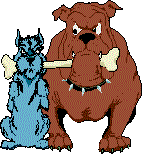Older dogs will put up with puppy indiscretions until the puppy reaches adolescence. At this time, the older dogs will "correct" the teenager, first gently and then with increasing severity as the young dog warrants. However, if the alpha dog is geriatric or ill, the younger dog will take over his position.
Due to our family packs being slightly different from those canine packs in the wild, we coddle our dogs, spoil them and try to make sure that the older dogs are carefully watched over. Thus, when your little canine pack begins to fight with each other, it us mostly due to their not knowing the proper pack hierarchy. Unfortunately, the older dogs lose their alpha position to the younger dogs. It is our job to make certain that a geriatric, or ill dog is separated from the younger dog(s), to avoid any injury. However, it is not our job to interfere with the position settings. Our interference is one of the main causes of these squabbles turning into nasty, skin tearing fights.
Should your dogs already have animosity, the best means of curing this is to first take them through basic obedience training. This teaches them that you are the alpha figure of the pack. Next, they should learn how to work simultaneously together. This is called Brace or Tandem training.
Through Brace training, the dogs learn to behave while in close proximity to each other and perform whatever you ask. This teaches them to control their outbursts and defer all leadership to you to dole out as you see fit.
Initially, Brace training is very difficult. You'll have to use a different leash for each dog. The dog closest to your left side should be the slower or more dominant dog. The dog on the outside should be of higher energy and/or the more submissive dog. The leash of the inside dog is held in your right hand and the leash of the outside dog is held in your left hand.
When working the dogs in Brace, you should have a "tandem name." This prevents the dogs from becoming confused about their own individual names. For example, you can use the word Dogs, Guys, Girls, or their breed names. Do not use a combination of part of their names. Remember, the sounds can be confusing.
Always say their tandem name before giving a command. When both dogs perform, praise them with that tandem name. If one dog does something wrong, use that dog's individual name before using the correction. We don't want the other dog to feel it is doing something wrong, when he is behaving.
Tips Archives



